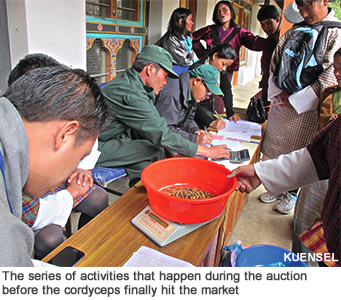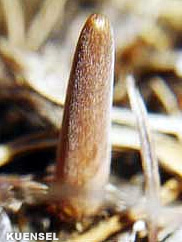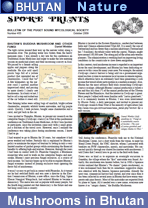| Cordyceps sinensis - Yartsa Goenbub in Bhutan |
| Highly
valued medicinal plant |
 |
Bhutan's Nature Yartsa Goenbub |
|
 |
Bhutan Information |
|
|
 |
 |
| Auction
2013 |
 |
A kilo of cordyceps fetches more than a million
 |
| Cordyceps auctioned at the Sephu gewog centre in Wangduephodrang went for Nu 1,101,000 a kilogramme, the highest price so far.
The bidding for the highest quality on June 20 began at Nu 600,000 a kg, with a woman buyer from Thimphu offering the best bid of Nu 1,101,000.
The highly valued medicinal fungi, which looked golden in colour, was selected as the best of four different categories of fungi displayed on a table that was surrounded by buyers on one side and the sellers on the other. |
|
The first group of fungi, rated as the lowest quality fetched only Nu 3,53,000 a kg.The next lowest quality fetched Nu 600,000 a kg, followed by Nu 8,21,000 a kg.
In keeping with the estimated price, a kg may contain 3,000 pieces of cordyceps.
As the price gradually went up, the sellers, sitting on the other side of the table, cheered up.
Seller Sangay Pem, 26, from Busa village, earned more than Nu 300,000 from the 360 pieces of cordyceps she collected.A piece of cordceps may have fetched Nu 367 for her.
But none of the sellers, who gathered for the auction, had collected a kg of the fungi. "Until now, I haven't got more than half a kg of the fungi," Sangay Pem said.
She was one among three collectors who got a good price. "We don't know what makes a difference in the price, irrespective of collecting the fungi from the same places," collector Gyem Tshering said.
More than 800 people of Sephu gewog collected the fungi from the Shukchu mangpa, Goenchukha and Thankhim mountains, which is a more than four days walk from the village.
The department of agriculture marketing and cooperative's marketing assistant, Sonam Wangdi, said the quality of the fungi is determined by size, hardness and colour. "The buyers bid, based on these characteristics," he said.
Yesterday, on the second day of the auction, the highest price fetched was Nu 9,01,000 a kg and lowest was Nu 1,52,000.
Today, the auction will be held at Gangtey gewog.
The collection and sale of cordyceps was legalised 2004
Although the collection and sale of cordyceps was legalised almost a decade ago, there is still no set standard to determine the quality of the highly valued medicinal fungi.
The practice so far in judging the quality has been to physically examine the appearance, size, weight and colour of the fungi.The medicinal content of the fungi is not accounted for.
 |
| Cordyceps
Sinensis |
|
|
During an auction, a committee, consisting of officials from the forest department, agriculture, food regularity authority, gewog officials and a member representing the buyer's party, agree on a minimum price by feeling the fungi with their hands and scrutinising its physical features.
"A good fungus should look golden colour with its size larger than the others," said one of the committee members. "Heavier the fungus, higher the price it fetches."
The largest size is more than two inches long. |
|
The team segregates best, medium and low quality from what is displayed before the buyers who sit on the one side of the table and sellers on the other.After giving the judgment, the team places a tag that represents the quality and based on that the bid begins.
Should there be a lab to see medicinal contents, the size may not play a role said seller, Gyem Tenzin from Sephu. "Irrespective of the same collection point it makes a big difference when it comes to price," he said. "In the absence of a proper pricing mechanism, the luck may continue to fix the price."
In an auction held at the Sephu gewog centre last week the same fungi collected from mountains of Shukchu mangpa, Goenchukha and Thankhim sold for different bids.
For instance, collector Sangay Pem of Busa village got a bid of Nu 1,101,000 a kg for her fungi while Zam's collection came under the Nu 353,000's category, the least quoted price.
"Sometimes, it's heartbreaking to see the variation in the price, regardless of the areas we collect from," Zam said. "Yet it's easy money for us."
The collectors bag cash in the hundreds of thousands within a month of the collection period.
But buyers agree with the physical appearance of the fungi in determining the price.
Ugyen Dorji, who has been exporting the fungi for five years, said the best quality of fungi is judged by its size and mass.He said 2,000 pieces of fungi, which make a kg is considered the best. "The low quality may need 12,000 pieces to make a kg," Ugyen Dorji said.
More than a dozen buyers, who took part in the auction, said they export the fungi to Singapore, Japan, China, Malaysia and Hong Kong along the same lines of price fixing mechanism as in the domestic market.
The renewable natural resource centre of Yusipang is in the process of collecting data on the cordyceps from the collectors to come up with a proper pricing mechanism.
The centre's deputy chief research officer, Puran Chettri, said the aim is to promote the fungi by knowing its scientific and commercial value. "We have a plan to do a lab test," he said.It will not only help understand the nature of the fungi but also in maintaining its sustainability.
 |
| This
article was contributed by Tenzin Namgyel, KUENSEL, Bhutan's national newspaper, July 2013 |
 |
| Bhutan:
Cordyceps harvesting legalised |
 |
June
2004
 |
| Cordyceps
harvesting legalised |
|
 |
top
| Auction
2007 |
 |
 |
| Cordyceps (Yartsa Goenbub) |
In
this year's auction in Choekhor, Bumthang auction bids for Cordyceps (Yartsa
Goenbup) increased to Nu. 330,000 a kilogramme up from Nu. 92,000 last
year.
The
lowest quality Cordycep went for Nu. 190,000 a kilogramme up from Nu. 42,000
last year. The price had escalated because the total Cordycep collection
had decreased to 19.31 kilogrammes from 60.9 kilogrammes last year, according
to a farmer. |
|
The
annual auction, which was held at the gup's office in Choekhor, was attended
by 200 sellers and 44 bidders.
 |
| This
article was contributed by KUENSEL, Bhutan's national newspaper 2007 |
|
Yartsa Goenbub categories
|
 |
Several buyers come to the village three days a week, and all the local collectors bring their matsutake, which are sorted into two categories:
Class A are specimens whose caps have not fully opened and whose partial veil is still more or less intact. Collectors can sell this class for US $5 per pound.
Class B are open-capped mushrooms and fetch $2. Most mushrooms sold are class A. Collectors make $650–850 per season, which constitutes over 40% of their income.
Information provided by Daniel Winkler 2009
| Mushrooms in Bhutan |
 |
| Information on Bhutan |
 |
|







